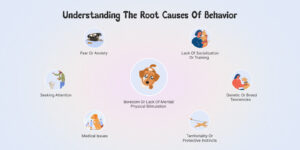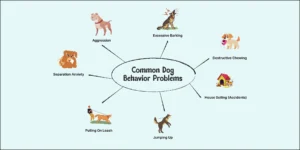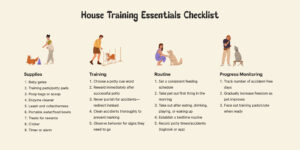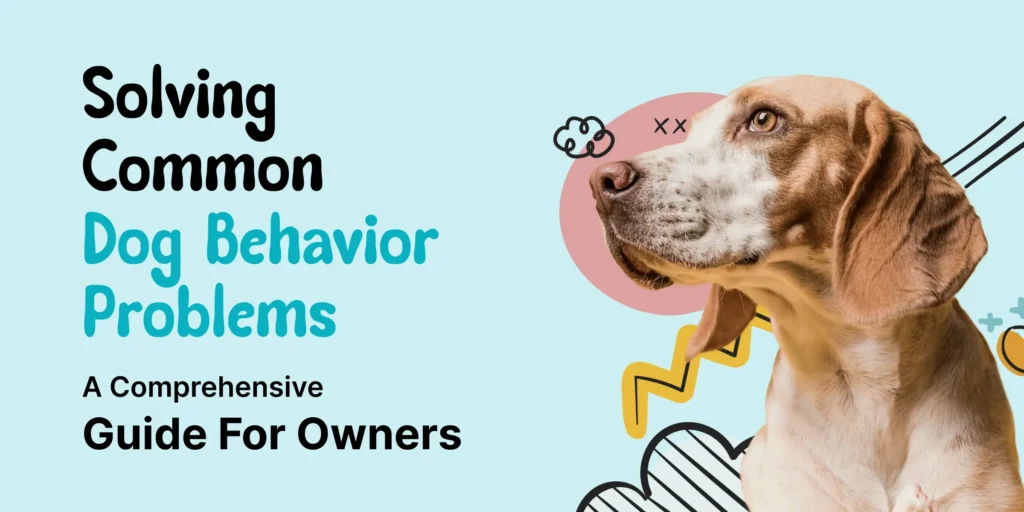Almost every dog owner gets frustrated and helpless sometimes, when their little pet chews on their favorite pair of shoes, barks excessively, urinates in the living area, but don’t blame yourself for not providing perfect training to your pet. This kind of behavior can make the most patient owner to feel stressed out. You are doing your very best and never be hard on yourself that you are failing as an owner. You are not alone.
This guide will help you to understand the most common dog behavioral problems such as disobedience, separation anxiety, excessively barking and helps you in treating it, through practical advice and with the use of positive reinforcement methods.
With the help of this guide, you will get to know why your dog behaves the way they do and learn methods to change their challenging behaviors into good behaviors by encouraging desired behaviors, which will lead to happier and peaceful life for the owner.
Through expert advice, this guide will walk you through the most common dog issues and offer straightforward and practical solutions for it.
Summary of Main Takeaways:
| Key Point | Description |
|---|---|
| Understanding Dog Behavior | Many ‘problem’ behaviors are natural dog actions misinterpreted in human homes |
| Identifying the Root Cause | Behavior is communication; addressing the ‘why’ is crucial for lasting change |
| Actionable, Positive Solutions | Focus on rewarding desired behaviors and managing the environment |
| Consistency and Patience Are Key | Behavior modification takes time, effort, and everyone following the same plan |
| Knowing When to Seek Professional Help | Some issues require the expertise of a vet or certified behavior professional |
| Building a Stronger Bond | Effective training enhances communication and trust between owner and dog |
What is problem behavior in dogs?
The dog behavior that we see as problematic such as barking, digging or chewing is innately present in them or these are the ways through which they want to talk with their owners. These natural behavior becomes frustrating and problematic when they clash with living environment of their owners, expectations or safety such as chewing is natural action of dog but if it chews favorite shoes or furniture of its owner, then it becomes problematic or barking, that is also a natural behavior, but if it happens throughout the day, it can lead to complaints from neighbors. It’s important to set realistic expectations as dogs also have basic needs and instincts. They are not born knowing the rules of human household. This is why rather than eliminating these natural behaviors, appropriate training is required to modify their natural drives. For example, chewing is natural behavior but training your dog what to chew and what to not is essential.
Always remember that behavior is a means of communication, when your dog acts in a certain way, it is very much possible that he is giving you signal about something. It can be needs, emotions or motivators such as fear, thirst, hunger, boredom, pain, excitement.
Decoding the ‘why’: Understanding the root causes of behavior
First and foremost thing to do in fixing your dog behavior is to understand why your dog is behaving the way he does. Treating the action (barking) without knowing the cause for it (boredom, pain, fear) won’t be effective in a long run.

Common underlying causes
- Fear or anxiety (including separation anxiety)
- Boredom or lack of mental/physical stimulation
- Seeking attention (positive or negative)
- Medical issues (pain, cognitive dysfunction, hormonal imbalances etc)
- Lack of socialization or training
- Genetic or breed tendencies
- Territoriality or protective instincts ( accidental reinforcement)
How to observe and interpret
Try to observe how much, when and in what situations your dog behaves the way they do to know what provokes his behavior.
Firstly, it’s important to consult a vet for diagnosing medical issues. Sometimes the medical cause is the reason for sudden behavior change of dogs.
Tackling common dog behavior problems: solution and training steps
To avoid undesirable dog behavior, following are some of the key principles which needs to be followed.
- Consistency is Key: Every person in the house should follow the same training plan, commands, rewards and expectations to make things clear for the dog. Each person must understand the training plan to avoid confusion for their dog.
- Positive reinforcement: Positive reinforcement means rewarding your beloved companion with a reward when they engage in a desirable behavior. It is the most effective method to encourage pleasurable behavior. Treats, toys and praise are some of the words which your dog may find motivating.
- Environment management: While training is underway, try to prevent dog from unwanted behaviors by managing environment. Keeping your important stuff out of reach and using gates as barrier until your dog is calm is important.
- Patience and realistic expectations: Fixing behavior takes time and efforts. Be consistent in journey and do celebrate small improvements.
Reminder
Training is a journey, not a race
Common dog behavior problems:
The common dog behavior problems are:

Problem 1: Excessive Barking
Understanding the ‘why ‘
There are many reasons which trigger dog barking. To understand the cause of their behavior, you should notice where, when and at what they bark.
Actionable solutions and Training and steps
- Identify triggers:
Watch what changes your dog behavior, it could be from people passing nearby, from other dogs or doorbells. - Management:
Manage the environment by blocking their view or use white noises. - Training:
Counter-conditioning: It means teaching your dog to remain calm when the trigger happens by changing emotional response of your dog towards the trigger. It could be done when first you expose your dog to low intensity of trigger and reward them when he stays calm.
Teaching quiet cue: say ‘quiet’ in a calm voice to your dog to make him understand the quiet command and when he becomes quiet, reward him immediately. - Addressing Attention-Seeking Barking:
Sometimes your dog may bark to seek attention from you, so ignore his barking and pay attention only when he is quiet. - Addressing Boredom barking:
Most of the time, your dog may bark when he becomes bore, this happens when there is no physical activity or mental stimulation. Providing puzzle toys or long lasting chews can be beneficial. - Prevention (puppies):
For puppies, it’s helpful to expose them to different sights and sounds, observe them keenly and provide lots of chews items to avoid them getting bored.
Problem 2: Destructive chewing
Destructive chewing is due to several reasons which are as follow.
- Exploration:
Puppies explore the world through their mouth, so they are likely to chew everything that’s in their reach. It could be shoes, furniture, clothes. - Teething:
Puppies begin teething at 3-6 months which causes their gum ache due to which they chew things that are in their reach. Cold rubber toy may be helpful to ease their pain. - Boredom:
More often, dogs chew on different things when they get bore to entertain them-selves and to burn the excess energy. - Anxiety:
Dogs chew things when they are anxious, which also includes separation anxiety. - Attention seeking:
Sometimes, the dogs are just being attention seekers, if your dog stops chewing as soon as you strongly react, it may be a sign that he’s seeking attention.
Actionable solutions and training steps
- Provide appropriate chew toys:
Appropriate or durable chew toys should be used with dogs to prevent them from chewing other stuff. Durable toys also helps dog to chew safely. Kongs or Nylabons are often suggested. - Make inappropriate items inaccessible:
Environment should be well managed so that inappropriate items such as shoes, furniture, valuables, remote control and dangerous items l are out of reach from dogs. - Teach what is allowed:
By using positive reinforcement method, teach your dog what is acceptable to chew and what is not. - Address Boredom:
Engage your dog in physical and mental activity such as exercise or puzzle toys to prevent him from getting bore, which could slow down frequency of chewing. - Recommendation:
Enrichment feeders or puzzle toys are often recommended. - Address anxiety:
Anxiety may also cause destructive chewing which majorly includes separation anxiety disorder. Helping your dog to reduce their level of anxiety may be helpful in treating destructive chewing. - Redirect inappropriate chewing:
Directing your dog toward acceptable toys when he chew unacceptable toys is important
Prevention (Puppies):
- Puppy proofing:
Make it sure that your home is safe for chewing prone puppies. - Providing lots of chewing options:
Provide multiple chewing options to your dog to prevent him from chewing unacceptable things. - Supervision:
Keep a sharp eye on your dog and always notice his actions.
Problem 3: House Soiling (Accidents)
House soiling means when your dog urinates or potty indoors, it explains the causes of it and how to treat it.
Understanding the ‘why’ :
- Incomplete House Training:
When training process is inadequate, then the dog may lack the proper time and place to urinate. - Medical Issues (UTI):
Health issues which includes Urinary tract infection may cause uncontrollable or frequent urination. - Marking territory:
Dogs may sometimes urinates small amount of urine to mark their area of space or living. - Excitement/submissive
When dogs are overly excited, they may urinate - Separation anxiety
Fear of being left alone by their owner leads to accidents inside the house for dogs. - Lack of potty breaks
If you don’t take your dog out for potty breaks, your dog may do potty indoors to relieve his self.
Actionable solutions and training steps
First visiting a vet is important because sometimes there are some medical issues such as UTI that leads to accidents inside the house.
- Review House Training basics:
Provide potty breaks frequently especially after when the dog eats, plays or walk, going outside with the dog and rewarding him immediately after he goes to motivate him. - Supervision indoors:
Keep an eye on your dog inside the house. Teach him how to control bladder ( crate training ), use baby gates to limit access where accident might happen, keeping your dog on a leash attached to objects or to you, so you can closely notice the signs, and take him outside for potty. - Cleaning accidents properly:
Use Enzymatic cleaner to clean dirty areas as it break the protein into urine and feces that other cleaners cannot do. Cleaning is important because the odor might encourage your dog for repeating accidents. - Addressing marking:
Marking is when your dog urinates in small amounts in different spots to claim his space. Cleaning can be helpful in reducing the smell so the dog doesn’t remember the area, spaying also reduces marking, redirect your dog towards outside so he understand the correct place to urinates. - Addressing excitement/ submissive urination:
Sometimes dogs urinate when they are overly excited. Try not to excite your dog during greeting to avoid excitement urination. - Avoid punishment:
Use positive reinforcement methods when your dog urinates in appropriate place, punishments can further worsen the situation if dog urinates out of fear or anxiety.
House Training Essentials Checklist

Prevention (puppies)
Follow the same plan, take him outside more often, rewarding him when he acts good, always keep an eye on him.
Problem 4: Separation Anxiety/Related Behaviors
Understanding the ‘Why’:
Dogs develop separation anxiety when they are being separated from their owner, spending plenty of time alone, anxiety is triggered when they clues of his owner leaving, it may cause them to panic and does destructive behavior ( pacing, barking, house soiling, chewing)
Actionable solutions and training steps
- If separation anxiety increases, seek guidance from veterinary behaviorist or a certified trainer specializing in separation anxiety. Avoid punishment as it further worsen the situation instead of solving it.
- Departure cues like putting your coat, grabbing your keys can be a sign to your dog that you are living, perform these actions without leaving so your dog learns that it doesn’t always means leaving or separation.
- Do leave your dog slowly and gradually, suddenly being absent may cause separation anxiety.
- Before you leave your dog, try to provide them some puzzle toys, treats or enrichment so they remain engage in that and doesn’t feel lonely.
- Leave and come silently, don’t make too much disturbance and noise.
- Before you leave make sure to provide puzzle toys to your dog so he remains mentally and physically stimulated.
- Teach your dog settle cue, so he remains calm and relax after you command him ‘sit and relax until I say you otherwise’
Prevention (Puppies):
For puppies, practice short and positive alone time from an early age.
Problem 5: Leash Pulling
Understanding the ‘why’:
Your dog may pull on the leash because naturally he walks faster than you, or if he get excited seeing other people, dogs or explores smell. Dogs are probably never taught to walk nicely. They might also put on the leash when accidently rewarded by the owners.
Solutions and training steps
By using positive reinforcement (treats, praise) teach your dog to walk without pulling.
- Technique:
Stop walking, when your dog pulls on the leash and continue or reward him when he slows down the pull. - Use appropriate equipment.
Front-clip harness (How it works)
In front clip harness, the leash clips are at the front of the chest not back, which gives you more control without hurting them. When your dog, pull on the leash, it gently turn them towards you, which becomes harder for them to move forward.
Head Halter (How it works)
Head halter is very gentle and works well with dogs, it goes around the dog nose and behind their head. When your dog, pull on the leash, it gently turns their head toward you making it harder for them to move forward. - Practice in low distraction area
Take your dog on a walk with little distractions (no other dogs, less people)
Give your dog some exercise before taking him out for a walk to reduce his excitement and energy to pull on the leash.
Prevention (Puppies):
If you have a puppy, start leash training early, make it a positive experience by rewarding him when he walk near to you.
Problem 6: Jumping on People
Understanding the ‘Why:
There are few reason due to which dogs jump on people.
- Seeking attention:
When your dog feel that he is being ignored, so he may jump on you to seek your attention. - Excitement:
Your dog may show excitement by jumping on you when he sees you. - Greeting behavior when untrained:
If your dog jumps on you, it may be a greeting gesture for them. Teach him the appropriate way of greeting. - Dominance (less common):
Sometimes, your dog may jump on you to show their supremacy, but its less common. - Reinforcement by owner :
Jumping behavior of your dog may be still reinforced, if you give negative reactions to him like saying him NO! or push him off because your dog gets the attention he wants, whether positive or negative.
Solutions & Training Steps:
- Teach your dog to sit when greeting people.
- Use leash when guests come in, so you can control your dog from jumping on people, or you can also use a baby gate to prevent dog crossing other area until he’s calm.
- Remain silent, don’t push or talk to your dog when he jumps on you, simply ignore him, until he keeps all of his four legs on ground because yelling at him is also giving attention to him.
- Reward him with praise, toy or treat when he calms down.
- Teach your dog self- control in exciting situations by practicing commands like ‘leave it, sit, wait, stay’.
Expert Tip
Give no attention to your dog (positive/negative) when he jumps!
Prevention (Puppies):
Start teaching manners to your puppy from the start, so it won’t be hectic later. Use positive reinforcement such as rewarding him when he calmly greet people.
Problem 7: Fear or Reactivity Towards Other Dogs/People
Understanding the ‘Why’
If your dog is reactive, or has fear from other people or dogs, he may manifest it by barking, trying to escape, growling. Following may be the reasons for it.
- When he has fear of other dogs, people or unfamiliar things.
- When your dog lacks socialization skills, it begins from an early age.
- If your dog is being attacked in the past, he may recall this bad past experience and generalize it.
- Your dog may be reactive if he’s in pain or discomfort.
- Some dogs are genetically more reactive than other, depends on their breed.
Actionable Solutions & Training Steps
- Fear or reactivity is a complex issue as it causes aggression in dogs but don’t worry! Seek professional help from a certified behavior consultant or veterinary behaviorist.
- Don’t punish fear because punishment will further increase intensity of fear leading to severe problem.
- Notice what triggers your dog (stranger, other dog)
- Notice the level or distance at which your dog starts reacting.
Example: Your dog may remain calm when person is 20 feet away, but starts barking when is only 10 feet away. - Avoid the triggers as much as possible, it will give a safe place to your dog and help him to stay calm.
- Manage encounters- if you see lots of people or dogs, try to cross the other side, increase distance from whatever increases your dog reactivity and fear.
- Modify your dog behavior by two key techniques
1. Try to use positive reinforcement to change your dog’s emotional response to trigger by giving him treat whenever he sees other dog, due to which he will learn to be happy not scared from other dogs.
2. Slowly and gradually expose your dog to the trigger from a safe distance where he doesn’t react, then gradually reduce the distance to the threshold level as the dogs become comfortable. - Teach focus exercises around triggers. Teaching your dog to learn commands like ‘watch, look at me’ is helpful to divert his attention from trigger.
Expert Tip
Work below the dog’s reaction threshold
Prevention (Puppies)
To reduce the frequency of reactivity among dogs, it’s advantageous to build socialization skills in him during early age (up to 16 weeks).
The exposure to different sounds, sight, people and vaccinated dogs is beneficial.
Breed-Specific Tendencies:
Every breed has predispositions to certain behavior.
Herding breeds ( e.g. border collies ):
Border collies may nip or circle, they like jobs. Give them tasks (fetch, agility)
High-prey-drive breeds (Huskies):
Huskies have strong drive to prey, to keep them under control, strongly recall your dog name and make him learn ‘leave it’ command, when he leaves chasing the pray, reward him immediately to train him accordingly.
Vocal Breeds (beagles):
Vocal breeds such as beagles bark a lot, teach them to learn ‘quiet’ or ‘enough’ command. Provide puzzle toys to make them busy and avoid barking out of boredom.
Guarding breeds (Rottweilers) :
Rottweilers are territorial, they bark at strangers coming home. Socialize him carefully and reward him when he stays calm in front of other people.
When to Seek Professional Help:
While this guide provide common solution for your dog issues, it’s important to understand that some issues are way too complex such as aggression which requires professional help otherwise it could lead to dangerous consequences.
Signs You Need a Professional:
- When your dog is aggressive towards other animals or people, you should seek professional help.
- When your dog is very anxious and is encountering panic attacks.
- Always make sure to visit a Vet first when you notice that your dog is going through sudden behavioral changes.
- If your dog is causing harm to himself, house, other animals or people, you many need to seek professional help.
- If your method of training is not working, you feel unsafe and overwhelmed, then it’s best to seek help from professionals.
- If you are not able to manage your dog’s interactions consistently or safely, you should seek help from professional trainer or certifies behaviorist.
Who to consult:
Consulting a vet is needed to diagnose any medical issue of your dog.
Consult Certified Professional Dog Trainer (CPDT-KA, CPDT-KSA) to help you teaching manners, obedience to your dog and also aids in treating common dog issues by using positive reinforcement methods.
Consult Certified Applied Animal Behaviorist (CAAB), Associate CAAB, or Veterinary Behaviorist (DACVB) for diagnosis of serious or threatening behavioral disorders such as (anxiety, aggression, compulsive disorders)
Reputable organizations for finding certified trainers/behaviorists:
- Certification Council for Professional Dog Trainers (CCPDT)
The CCPDT is the leading independent certifying body for dog trainers and behavior consultants. Use their Certified Dog Trainer & Behavior Consultant Directory to search by ZIP/postal code, name, or specialty:
https://www.ccpdt.org/dog-owners/certified-dog-trainer-directory/ - International Association of Animal Behavior Consultants (IAABC)
The IAABC certifies animal behavior professionals worldwide. Their Find a Consultant tool connects you with credentialed behaviorists skilled in handling complex issues across all species:
https://iaabc.org/find-a-consultant/ - American College of Veterinary Behaviorists (DACVB)
DACVB diplomates are veterinarians with advanced specialty training in animal behavior. Their site offers information on locating a Board-Certified Veterinary Behaviorist:
https://www.dacvb.org/However, you have to seek professional help in case of dangerous and serious disorders, like aggression or compulsive behaviors. Seek professional help in diagnosing your dog issues and providing proper treatment to ensure safety of yours dog and yours!
Consistency and Patience: The Pillars of Progress
Breaking down the established behavior isn’t easy at all, it takes time, effort, commitment and continuous support from you and everyone in the house. Take a deep breath, you can do it just show consistency.
Teaching manners sometimes won’t bring major difference, dogs learn when things are repeatedly done by using positive reinforcement repeatedly. Be committed and consistent while training your dog because if you change the rule each time, it would slow down the progress by confusing your dog.
- Training isn’t easy at all as it sounds, it’s OK to feel overwhelmed and frustrated, seek help from professionals if you feel exhausted. You are bringing a change!
- Take shorter breaks when you feel tired, then return with a fresh mind, be happy when you see little improvement in your dog and reward him.
- Focus on building and maintaining sweet and trust worthy bond between you and your dog.
- Notice small improvements like shorter bark, walking a moment without pulling leash, fewer accidents. Give your dog and yourself a treat for these improvements.
- Focus on encouraging positive interactions between you and your dog.
Expert Tip
Be patient with your dog and yourself. You are both learning!
Additional Resources & Tools
- Training treats: Rewarding your dog with treats when he behaves appropriate and good.
- Puzzle toys/Feeders: Provide your dog puzzle toys or enrichment feeders to help him prevent boredom and enhance mental stimulation.
- Durable chew toys: Appropriate durable chew toys like Kongs and Nylabones should be provided to satisfy your dog chewing needs.
- Crates, baby gates, front clip harnesses, leashes:
Use crates, baby gates, specific leashes to control your dog behavior or use clip at the dogs chest which causes your dog to turn toward you when he pull a leash. It’s a gentle way to redirect your dog towards you without applying force. (front clip harnesses)
Look and read high rated and reputable titles on positive reinforcement dog training to increase knowledge about dog training using positive reinforcement. Such as,
- Don’t shoot the dog! By Karen pryor
- Culture clash by jean Donaldson
- The power of positive dog training by Pat Miller
Before starting any behavioral training, it’s important to consult a veterinarian to diagnose if there are any medical condition (UTI, hormonal issues, pain) that causes abnormal behavior.
Quick Reference Table: Problem, Cause, Initial Action
| Behavior Problem | Likely Cause(s) | Initial Action/Tip |
|---|---|---|
| Excessive Barking (at door/window) | Fear, Territoriality, Attention, Boredom | Management: Block view/use white noise. Reward quiet. Increase exercise/enrichment. |
| Destructive Chewing | Boredom, Anxiety, Teething, Exploration, Attention | Provide appropriate chew toys. Increase exercise/enrichment. Manage environment. |
| House Soiling (after trained) | Medical issue, Incomplete training, Anxiety | Vet visit FIRST. Review training basics. Increase potty breaks. Clean thoroughly. |
| Destruction/Vocalization (when alone) | Separation Anxiety | Desensitize to departure cues. Practice short absences. Provide enrichment. |
| Leash Pulling | Excitement, Lack of training, Reinforcement | Stop-start method. Use front-clip harness. Reward loose leash. |
| Jumping on People | Attention seeking, Excitement | Ignore jumping (turn away). Reward 4 paws on floor/sitting. Manage greetings. |
| Fear/Reactivity (other dogs/people) | Fear, Lack of socialization, Past trauma | Seek professional help. Manage distance from triggers. Counter-condition. |
Conclusion:
To fix a behavior, it’s important to identify the reasons behind it. Once the causes of problematic behavior are known, it becomes easier to modify the behavior by reducing or eliminating the triggers.
Remember, by addressing your dog issues, you are no doubt acting as a responsible dog owner. Giving value to these issues increases positive relationship of yours with your dog and also brings happiness and peace in both of your lives.
The efforts you show in treating your dog behavioral issues will bring you one step closer to the well-mannered dog you deserve. Just be patient and consistent in your journey to bring a change. You’ve got this!
To make it smooth, it’s better to start with one behavior at a time, apply the methods and seek professional help if needed. Starting with multiple behavior, leads to confusion which further worsen the situation.
Disclaimer:
The information provided here is for educational and informational purposes only and is not intended to replace professional veterinary advice, diagnosis, or treatment. Always seek the advice of your veterinarian or a qualified behavior professional with any questions regarding your pet’s medical or behavioral condition.




